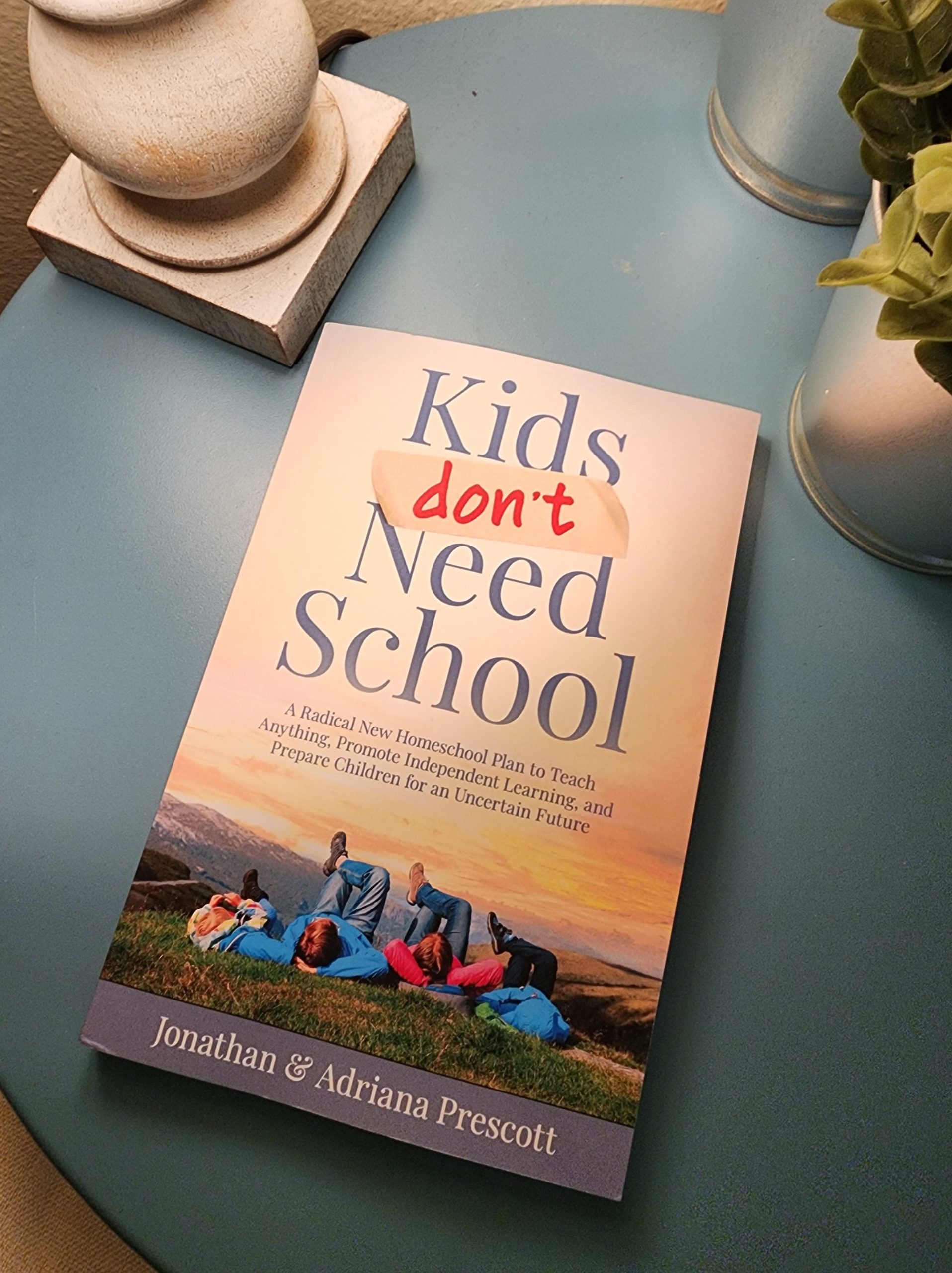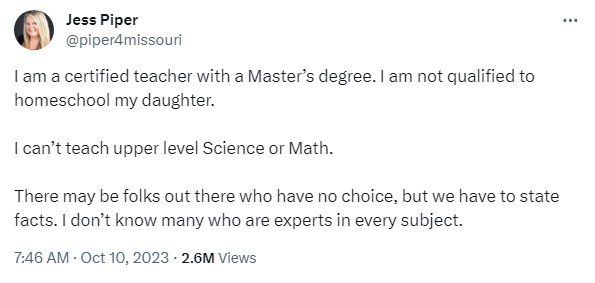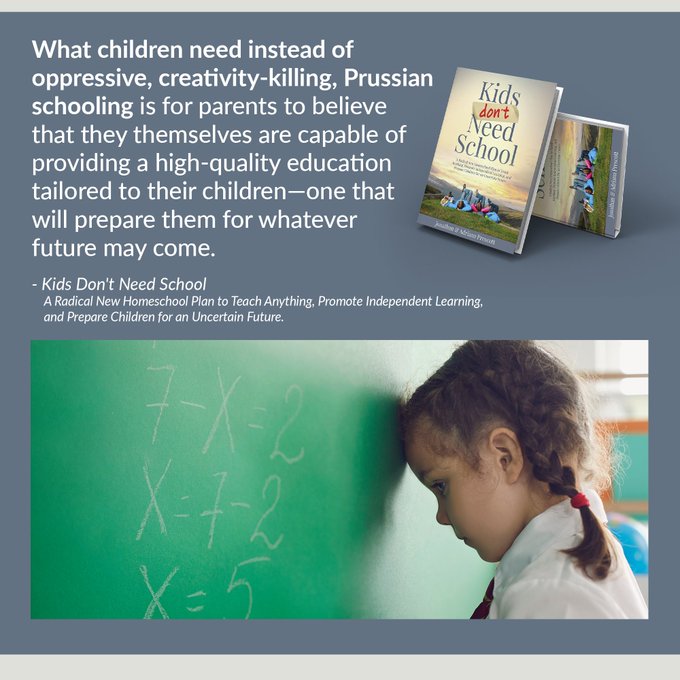In Kids Don’t Need School, veteran homeschool parents Jonathan and Adriana Prescott lay out a radical new approach to home education that empowers children to love learning, build real-world skills, and take charge of their future—all before age twelve. Specifically, the book covers:
- The untold history of tests and grades
- What to do about discipline and punishment
- How to strengthen the parent-child relationship
- How the traditional classroom steals children’s agency
- What to teach your child at every stage of development
- Intuitive ways to notice and nurture your child’s latent skills
- How to raise a competent, self-confident, well-adjusted child
- How to know when to “back off” and let your child self-teach
- Little-known resources to help your child master any subject quickly
Whether you’re seriously considering home education for the first time or you’ve been doing this for a while, Kids Don’t Need School will help you deepen your relationship with your child, build mutual respect in your household, and give your child the elite education they need to succeed in an uncertain world.
FORWORD by Elijah Stanfield
I’m so happy to finally be diving into the book by Jonathan and Adriana Prescott, Kids Don’t Need School. I’ll be reviewing this book chapter by chapter. First up, the Foreword!
The Foreword is written by Elijah Stanfield, illustrator and co-creator of the delightful The Tuttle Twins books, which encourage critical thinking and the principles of a free society.
Stanfield starts off strong by saying, “The choices a parent makes in the rearing and educating of their own children are so personal and meaningful, I consider them sacred.”
He likens the idea of sending kids to school for eight hours a day to be exposed to all types of harm “communal insanity.” Homeschoolers’ very existence “is a light that pierces the darkness of the government school institution” and combats the hold that society grants to these institutions over our children.
Stanfield writes, “I encourage you to change your way of thinking …
Believe that kids don’t need traditional, conveyor-belt style schooling to be educated or socialized.
Believe that with your support, encouragement, and guidance …. you can build a trusting relationship with your child based on respect for each other.
And that above all else is what will best enable your children to reach their own greatest potential.”
CHAPTER 1: Not for Everyone?
Way back in my early days of homeschooling, I read a book that profoundly influenced me. It was “The Underground History of American Education” by John Taylor Gatto. It was a huge book, but I ate up every word and along the way, my whole understanding of what education really was changed. I read more, digging into books by John Holt, Raymond and Dorothy Moore, and others. It became apparent to me that the way our society looked at education was simply wrong.
So, while my heart was already in love with homeschooling, these ideas confirmed in my head my resolve to keep my kids out of the system. Many of Gatto’s ideas are echoed in the Prescotts’ explanation of “the dark origins of modern schooling.”
But can everyone homeschool? I’ve been guilty of thinking what the Prescotts point out in chapter 1 of their book, “Kids Don’t Need School.” I’ve said to others, “Homeschooling isn’t for everyone.” But maybe it is?
There are some common reasons for not being “able” to homeschool: finances, chronic illness, lack of patience, absence of a spouse. But the stakes are high! They share a list of statistics showing how the American education institution is failing our children. As the Prescotts write, “These schools are babysitting services,” and likely even worse.
While folks argue all the time that their own public schools are among the best, “the bottom line is that children need their parents to care for them to nurture the bonds of family and the love of learning.” Proponents of public schools may argue that schools are great, but can they argue with this idea?
As to the argument that public schools are the appropriate gatekeepers of things like sports and the arts, well any long-time homeschoolers can tell you that they are filled up with sports and art and music and dance and science clubs and field trips! And the schools have utterly failed at teaching important subjects such as financial literacy, ethics, and critical thinking skills.
Chapter 1 ends with this conclusion: “Children don’t need school.”
“So what do they need instead?”
Pope St. John Paul II wrote in his Letter to Families in 1994, “Parents are the first and most important educators of their own children, and they also possess a fundamental competence in this area. They are educators because they are parents.” The Prescotts' philosophy tracks right along with this.
CHAPTER 2: What Children Need Instead
So if our kids don’t need school, what do they need instead? In their book, Kids Don’t Need School, the Prescotts tell us that the answer is hiding in plain sight. Turns out what they need is us! Parents need to believe that they are capable of providing all the education our kids need.
Pope St. John Paul II wrote in his Letter to Families in 1994, “Parents are the first and most important educators of their own children, and they also possess a fundamental competence in this area. They are educators because they are parents.” The Prescotts’ philosophy tracks right along with this.
We were already homeschooling when COVID hit, but for millions of American families, staying at home, doing school stuff together, having more family time was transformational. It opened many parents’ eyes to what they were missing out on by having their children gone for most of the day.
The truth is there is not a substitute for the family unit and parents’ bonds with their children. The Prescotts tell us, “Education is parenting.” Before our kids go to school, we know this to be true. Why do we abandon this idea once they head off to a government school? Kids spend literally thousands of hours away from their family when they go to school, about 16,000 hours actually. Their peer group becomes primary in their social development, and they receive the bulk of their intellectual and ethical formation from people other than their parents.
The Prescotts give some great ideas about discipline and expound on how a home environment informed by healthy conflict resolution is the best environment for your children.
Things like choosing a specific curriculum take a back seat to the parent-child relationship. Whatever tools you choose to teach your children will only succeed if you have a philosophy of teaching for all types of learning. A well-formed philosophy will lead to what they call “the holy grail of education—motivation.”
CHAPTER 3: Guiding Your Child’s Natural Learning & Motivation
“As long as the environment at home is peaceful, low stress, and conducive to learning and self-teaching, children can learn anything.”
What a challenging statement! It’s not that I don’t agree with it, but life can be tough. A goal of peace and little stress in the home is a worthy one for our families, but wow can that be hard to achieve sometimes.
The Prescotts give us some advice on how to achieve that. They first point out one of the most common follies of the homeschooling family: too many extracurriculars and outside activities.
Now that I only have two kids left at home, I can see the wisdom in being more careful about the time sink of activities outside the home, since we are naturally doing less now than we had six kids at home.
We always did try to contain the chaos—only one sport that all kids participated in and not many activities during the summer months. But we still felt always busy (and frazzled if I’m honest here). Lots of homeschoolers can relate to feeling like some weeks have more running around than home time.
One of the things we love to say about homeschooling versus public schooling is that it gives our children the opportunity to indulge in their interests for as long as they want and as deeply as they wish. Rather than ending a lesson to run off to the next class period, they can spend all afternoon reading about the Civil War or trying their hand at quilting or drawing comic strips.
But do we interfere with those interests when we pull our children off to run to the next activity? It can be a balancing act!
The Prescotts rightly point out that coercion is not a reasonable path to learning for your children. Our children need to have agency (ability to make decisions about their own lives) in order to have true motivation to learn.
Healthy motivation does not come at the end of a stick. This is a temporary and coercive technique that does not encourage a love of life-long learning.
So how do you encourage self-motivation in your children? In two ways: 1) Give them the freedom to access their own imagination and creativity and 2) Give them the ability to act on those things.
You can encourage this in your home by providing opportunities for your children to try new things, and as Maria Montessori explained, don’t try anything too challenging too early. Build confidence in your children with little wins over time!
Watch and learn what your children are drawn to and interested in. Build on those interests to bring in reading, mathematics, history, and critical thinking skills. And read a lot at home with your children.
Finally, the book discusses the Three Pillars of Homeschooling Pedagogy: Philosophy, Methodology, and Observation. Your family needs its own philosophy of learning, a methodology of practices that support your children’s learning, and observing what works and what doesn’t.
This section is worth reading slowly to absorb these ideas. Give it with some thoughtful processing of this in a personal way as it relates to your family. It is a really good exercise in being more deliberate about your own homeschooling choices and considering what you truly want for your children.
CHAPTER 4: What if Your Kid Falls Behind?
When I first began homeschooling, I read a book that had a profound influence on me. It was Raymond and Dorothy Moore’s work titled, Better Late Than Early.
The point of the book was that children learn on timelines that often do not line up with conventional expectations of learning.
Our society expects us to put our kids in a grade box. “What grade are you in?” homeschoolers so often hear. After puzzling out what grade they were “supposed” to be in, I answered, but the real answer was, “Actually, he’s in 3rd grade, but also 5th, but also 2nd …” depending on whether he was doing 3rd grade math and 5th grade writing and 2nd grade reading.
It is safe to say that we did NOT fit into those set grade boxes. At all.
I never did understand when I heard other homeschoolers say that they were behind. It often came up when we would invite friends over or shared information about an activity. “Oh, we’d love to come, but we’re so behind.”
Behind who?
One of the absolute joys of homeschooling is settling into the idea that our children are right where they ought to be.
It helped that we didn’t use a boxed curriculum. I put together resources and courses and activities that suited each child where they were.
Modeling your expectations for your kids on the schedule of a public school system will only end up frustrating you and your children. You’ll end up pushing too fast in some subjects, lingering too long on those already mastered, and missing out on encouraging a true love of learning. The Prescotts break down these misconceptions of what it means to be on-track or “behind” in Kids Don’t Need School.
Instead of following a set scope and sequence, they encourage us to teach to mastery, not a grade. Knowledge moves from familiarity to proficiency to mastery.
They explain Dr. Maria Montessori’s Four Planes of Child Development, a far better model to evaluate your child’s progress.
Understanding this approach to child learning is crucial to be able to encourage healthy development, physical, mental, social, spiritual, and moral. A strong parent-child bond is key to this outcome.
CHAPTER 5: Deconstructing Curricula – Why the “Right” Curriculum Is Not as Important as You Think
You can spend a lot of money on curriculum – A LOT!!
When I first started homeschooling, there were not as many curriculum providers and resources as there are now, not by a long shot. But today … well you can fill up your shelves to the brim. But is that what you should do?
Curriculum is a catch-all term for the books and material you can buy that teach a subject. They tend to be written according to some “standards.” But as the Prescotts explain in their book “Kids Don’t Need School,” these standards are incredibly subjective. After all, who is to say exactly what everyone is to know about every subject?
Detaching from “standards” is one of the first steps to achieving learning freedom. They explain, “Imagination cannot be taught from a curriculum.”
Embrace the power of homeschooling by seizing “one of the greatest benefits of home-based education—you get to tailor any and all curriculum to your child’s needs.”
As a homeschooler, you also have the opportunity to teach to your child’s learning style, auditory, visual, or kinesthetic.
And one of the funny quirks of homeschooling (which is actually a natural pace of learning) is that you’ll often have your individual kids learning subjects at different speeds. You might have a child who is learning 5th grade math, reading at an 8th grade level, and doing beginning piano. Homeschooling lets you customize their learning in this way.
If you really want to capture more of the power of homeschooling, step outside the box! The curriculum box, that is. While boxed curriculum makes it easy to compile a set of materials, you’ll end up spending a lot of money and likely won’t be entirely satisfied.
“But curriculum is just information,” the Prescotts explain. It should be pulled together to reflect what you hope your children will learn.
You can curate a set of books, materials, and resources that fit your child and your family best, often for little or no cost. Borrow from the library, watch YouTube videos, visit educational places in your community, or partner with other parents to form a learning co-op.
Just remember, “The time and effort used in creating a custom information base for your child is worth it because being in full control of what gets instilled in your children’s minds is priceless.”
CHAPTER 6: Can We Afford to Homeschool?
How much does it cost to homeschool? In “Kids Don’t Need School,” the Prescotts cite an average cost of $600 per student per year.
But anyone with lots of kids knows that that “per student” part isn’t necessarily true. The more kids you have, the more materials you share among grades and reuse year after year.
The Prescotts acknowledge that homeschooling costs money. But how much is up to you!
Many parents considering homeschooling are worried about the costs. And it’s not just materials and curriculum. For many families, it’s the loss of an income.
The Prescotts address these concerns. They explain that working itself has costs and most of these offset a portion of the loss of income. But going further, they explain that it is not a given that a parent must quit a job to homeschool.
Every family is different, and there is no one-size-fits-all financial plan for homeschooling. But there are options for all types of budgets and working situations.
The key is two-fold: First, you need to fully commit to deciding to homeschool your children. This involves setting goals and recognizing that you are investing in “the vitality of your children’s minds and the health of your family’s relationships.”
Then, you need to create a plan. Learn how to get homeschool resources cheap or for free. Work on your family budget. Create a timeline for starting homeschooling, whether that is now or in the coming months.
“The fact is, if you want to change the path your family is on, you have that power.”
CHAPTER 7: The Ten Most Common Homeschooling Styles
Do you use a particular homeschool style? What do you love about the approach you’ve chosen? Have you successfully combined styles into a way of learning that fits you and your children well?
Chapter 7 of “Kids Don’t Need School” takes a quick look at 10 different homeschool styles: Classical Homeschooling, Classical Conversations, Charlotte Mason, Waldorf, Unschooling, Montessori, School at Home, Unit Studies, Eclectic/Relaxed, and Forest School.
I’m familiar with these styles, except for one. I had never heard of “Forest School” before. It originated in the 1950s in Denmark and Sweden and encourages learning outdoors. Fascinating!
Most families end up using a combination of methods. It is one of the major benefits of homeschooling! We’re able to customize our learning strategies for specific children, interests, and seasons.
CHAPTER 8: How Much Time to Actually Spend Homeschooling
The structure of Prussian system-based public schools can be hard for some new homeschoolers to get away from. Many will ask, “How long should we actually homeschool our kids?” They are wondering how many hours a day they have to “do school.”
But this question doesn’t make much sense in a homeschool environment. At home, kids are able to pursue their interests in a way they can’t in an age-segregated, topic-controlled classroom. Time spent teaching a subject doesn’t always equal time spent learning.
And more time in the day to study shouldn’t mean that you do all the things and pack in academic work for hours at a time. Homeschooling is vastly more efficient than teaching in a public school classroom. Parents and kids can take the time saved to learn about what interests them, pursue a hobby or sport, play music, bake, hang out with friends, and just live life.
This chapter then details what a typical homeschool day might look like by looking at various planes of development, from the infancy stage to the childhood stage to the adolescence stage through the maturity stage. This is an enlightening way of looking at how children learn as they grow to adulthood.
Is it possible to accept that the answer to “how long should we homeschool each day” is actually however long you want? Understanding this is a key step on the path to educational freedom.
CHAPTER 9: What About Socialization?
This question is the big boogeyman. I doubt there are many homeschoolers who haven’t been asked this question or a variation or it. “Do they have any friends?” “Do they ever get out?” “How are they going to learn to interact with other people?” “Do they know anyone not like them?”
The Prescotts carefully explain the difference between the term socialization and the act of socializing. In the education field, the term socialization ignores the primary socialization of the family and home. Instead, they focus on social learning, which let’s be honest is a type of social conditioning. This focuses on peer groups and social structures that are actually unnatural in the world.
Why does the state focus on this type of socialization? Well, the answer is long, but not necessarily complicated. Compliant and homogenous populations tend to be easier to control for any number of political, social, economic, and military objectives.
When the charge of inadequate socialization is lobbed at homeschoolers, it is a way of objecting to the fact that homeschoolers are less likely “to accept the state and not the family as the cornerstone of society.”
There were many times in our years of homeschooling that I kind of wished we didn’t have so much “socialization.” When my kids were too young to drive themselves, we could end up out of the house, interacting and socializing with others, for most of the days of the week. Homeschool co-ops, sports, art classes, piano lessons, volunteer work, church, visiting relatives, having dinner with friends, taking a girls’ friend group ice skating, going to a homeschool dance.
But truly, the best time they had socializing was when they were allowed unstructured time to spend with family, friends, or even just by themselves. That is one of the main benefits of homeschooling—being able to pursue the opportunities for genuine and good learning and growing as social members of a family and the wider community.
CHAPTER 10: Agency: The Heart of Self Education
My oldest son was once asked, “So your mom is your teacher?” He scoffed and replied, “I teach myself.” To be honest, when I heard that, I felt a little pinch in my heart. No credit for all the devoted hours I put into his homeschooling? But then, that pinch swelled into pride at his answer.
Isn’t that what we all actually want? For our kids to be able to be independent and confident learners?
The Prescotts explain the concept of “agency” as “the degree to which an individual has the ability to make decisions about their life.” This is what we desire as human beings and it is what God blesses us with through the gift of free will. This freedom is what allows us to grow in moral responsibility. Learning in freedom gives us this strength.
But can children be allowed to make their own decisions about their education? Wouldn’t that mean they demand to play video games all day because their stated life goal is to be a game developer?
It is true that children need direction. But this direction should come from observation and guidance, not a rigid schedule in which the child has no agency.
There should always be a “hand-off” where a child starts to take responsibility for his or her own independent learning. “With agency, children will want to be able to command themselves and guide their own future.”
CHAPTER 11: What Does Your Child’s Future Hold?
Is college for everyone? Not at all! There are many professions that require a college degree, but not every child is suited or is even going to be interested in pursuing a college education. Entrepreneurship, the trades, and independent learning are often the best outcomes for young adults.
Homeschooling your children in freedom and giving them agency can leap them ten years ahead of their peers. By claiming the freedom to determine their own path of education, with proper guidance and support from you, they can more easily see the path they want to take as adults.
Homeschooled children have greater confidence in learning about multiple subjects, which will translate into being able to work across multiple skills and industries in their adult life. The ability today to monetize a hobby or interest is unprecedented.
A supportive and lively homeschool environment is often the breeding ground for a small business or specialized service. There are many successful businesses that started as a result of a homeschooled child’s idea. The freedom baked into your homeschool choice gives children the agency and skills needed to pursue whatever they are good at and feel called to.
CHAPTER 12: Housekeeping, Bookkeeping, and Homeschool Laws
Are parents qualified to teach their children? This was a recent post made on X.com:
There were millions of views and thousands of responses to this from homeschooling parents. As you might expect, they wholeheartedly disagreed with Ms. Piper.
As the Prescotts explain in their book, “Kids Don’t Need School,” this post misses one fundamental point. The skills that Ms. Piper gained in her training to be a teacher involved learning how to teach a group of students.
Homeschoolers learn as individuals. Parents are personally invested in their children’s success. They intimately know their children’s temperaments, inclinations, temptations, and gifts. These are the experts, not a teacher with over 100 students each day.
The nuance of this post is the implication that homeschooling should not be allowed by a society, that laws should govern this type of learning environment. But there are already laws in place. A prudent homeschooling parent will learn about and sufficiently comply with state regulations regarding home education.
This involves learning the laws, maintaining adequate recordkeeping, creating a high school transcript, obtaining required testing, and issuing a diploma.
CHAPTER 13: The Uncertain Future
In our present culture war, “education is the battlefront.” The Prescotts explain, “Homeschooling is more than teaching; it’s an act of war against ideologies and the ideologues possessed by those who would, given the opportunity, target your children to steal, kill, and destroy them, spiritually, psychologically, or even physical.”
While everyone at first chooses to homeschool for personal reasons, it quickly becomes evident that this choice has the power to turn the tide of this culture war and to protect the institution of the family in society.
When education was put under the control of the government, it was ultimately an assault on the family. “Homeschooling is the recapture of parenting.”
The range of skills a homeschooled kid has, their flexibility, problem-solving skills, and above all their agency, strengthens our children to be able to survive and thrive in an ever-changing world.
There is an upward trend to the homeschool movement. More and more families are making this choice, especially after the eye-opening effect of having children at home during the pandemic lockdowns. This increase in the number of homeschoolers will benefit homeschooling families politically and practically, as more resources become available.
CHAPTER 14: For Everyone
Kids don’t need school! That is abundantly clear at this point. What do they need? They need their own agency, encouragement of internal motivation, peaceful parenting, appropriate mentoring, and the fostering of skills, cultivation of family values.
This book, “Kids Don’t Need School” is remarkable and worth reading by everyone, not just homeschooling parents. It is a well-researched and strong argument for the benefits of the best type of homeschooling, one that grows in love and freedom with a heaping dose of practicality and advice. Kudos to the Prescotts for this fantastic work!





